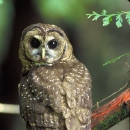This Final Environmental Impact Statement (Final EIS) describes and evaluates nine alternatives for an experimental removal of northern barred owls (Strix varia varia) (barred owl) on a scale sufficient to determine if the removal would increase northern spotted owl (Strix occidentalis caurina) (spotted owl) site occupancy and improve population trends. Results from these experiments would be used by the U.S. Fish and Wildlife Service (Service) to inform future decisions on potential long-term management strategies for barred owls.
Publication date
Type of document
Policy
Facility
Program
Species
FWS Focus




